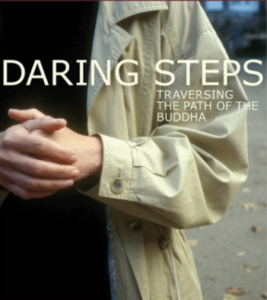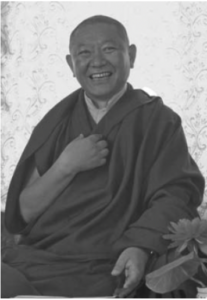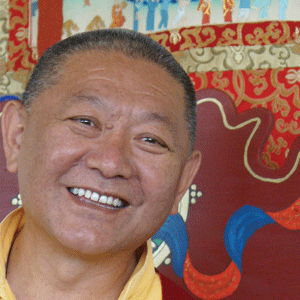The following article is adpated from
Daring Steps: Traversing the Path of the Buddha

By Ringu Tulku
Edited and translated by Rosemarie Fuchs
The following article is adpated from

By Ringu Tulku
Edited and translated by Rosemarie Fuchs
When should we counteract our difficult emotions, and when should we go with their energy? How we are advised to deal with our emotions varies according to which vehicle of Buddhism is in focus.
When dealing with strong emotions, a Vajrayana practitioner does not have to use deliberate means to stop them. Unlike in other systems, the Vajrayana provides very skillful methods so that the negative emotions are used in order to transmute themselves. This is a very characteristic feature of the Vajrayana approach to practice.
In the Shravakayana context, effort is directed at counteracting our emotions. When, for example, strong anger or attachment arises, deliberate effort is made to generate its opposite, like loving kindness or nonattachment. Once this is successfully achieved, the negative emotions have no opportunity to surface, since opposite emotions, like anger and loving kindness, cannot be present together at the same time. In this way, the negative emotions are reversed through giving rise to the corresponding positive ones.

Within the context of the Mahayana, the practitioner takes a further step and seeks to understand his or her emotions and see their nature. When anger comes up, we try to look at ourselves and our anger in order to see the egolessness of our mind and the emptiness of that anger. There are different methods that lead us to see the ultimate nature of ourselves and our emotions. Using these methods, we will understand that the nature of everything is subjective. Anger, as everything else, is not something solid, something truly and independently existing. Through this understanding, the negative emotions are counterbalanced and positive emotions gradually arise.
Following the Vajrayana teachings, we do not give up or reject anything; rather we make use of whatever is there. We look at our negative emotions and accept them for what they are. Then we relax in this state of acceptance. Using the emotion itself, it is transformed or transmuted into the positive, into its true face. When, for instance, strong anger or desire arises, a Vajrayana practitioner is not afraid of it. Instead he or she would follow advice along the following lines: Have the courage to expose yourself to your emotions. Do not reject or suppress them, but do not follow them either. Just look your emotion directly in the eye and then try to relax within the very emotion itself. There is no confrontation involved. You don’t do anything. Remaining detached, you are neither carried away by emotion nor do you reject it as something negative. Then, you can look at your emotions almost casually and be rather amused.
When our usual habit of magnifying our feelings and our fascination resulting from that are gone, there will be no negativity and no fuel. We can relax within them. What we are trying to do, therefore, is to skillfully and subtly deal with our emotions. This is largely equivalent to the ability of exerting discipline.
Generally speaking, to be able to apply the methods of the Vajrayana, a great deal of discipline is required, far more than is necessary within the context of the other vehicles. It is a matter of first knowing the technique to apply, and then of actually applying it. This is not easy, since whatever is there is dealt with directly. The negative emotions themselves are used. The process is almost like using poison as medicine. For this reason, a high degree of discipline is necessary. We need the awareness and courage first to see clearly whatever is there and then to accept and endure it, no matter how negative it may be. Strong anger, for instance, is a very intense and fierce emotion, and is usually experienced as being totally overpowering. It is not a minor thing, but constitutes a real challenge. If we are able to relax within that kind of feeling, we will be able to relax within everything. Once this capacity is acquired, it will not matter how strong our emotions are—it is even said that the stronger they are the better. Yet, if we are not skillful enough, we will not be able to apply these subtle methods.
Once we have gained the necessary knowledge and skill, this practice is very easy, since we simply make use of what we have and are at the moment. With the prerequisites at hand, this is not difficult at all. Whatever negativity surfaces, that is used as our strength, as our main practice. Nagarjuna’s verse refers to someone who is highly intelligent and disciplined and at the same time very skilled and capable. To practice the Vajrayana, an individual must be able to face any negativity that comes up, and to use that negativity without losing control. This requires a high degree of intelligence, combined with an equal amount of discipline and skill. For such a person, the Vajrayana methods are more excellent than those of the preceding vehicles.
 Ringu Tulku Rinpoche was born in Kham Lingtsang, in eastern Tibet, and was recognized by His Holiness the Sixteenth Gyalwang Karmapa as the incarnation of one of the tulkus of Ringu monastery, a Kagyüpa monastery in his home province. He studied with some of the most distinguished khenpos of the Nyingma and Kagyu traditions and received teachings from many outstanding masters, including Thrangu Rinpoche, Dodrupchen Rinpoche, Dilgo Khyentse Rinpoche, and the Gyalwang Karmapa. He is the author of Path to Buddhahood and The Ri-me Philosophy of Jamgön Kongtrul the Great.
Ringu Tulku Rinpoche was born in Kham Lingtsang, in eastern Tibet, and was recognized by His Holiness the Sixteenth Gyalwang Karmapa as the incarnation of one of the tulkus of Ringu monastery, a Kagyüpa monastery in his home province. He studied with some of the most distinguished khenpos of the Nyingma and Kagyu traditions and received teachings from many outstanding masters, including Thrangu Rinpoche, Dodrupchen Rinpoche, Dilgo Khyentse Rinpoche, and the Gyalwang Karmapa. He is the author of Path to Buddhahood and The Ri-me Philosophy of Jamgön Kongtrul the Great.